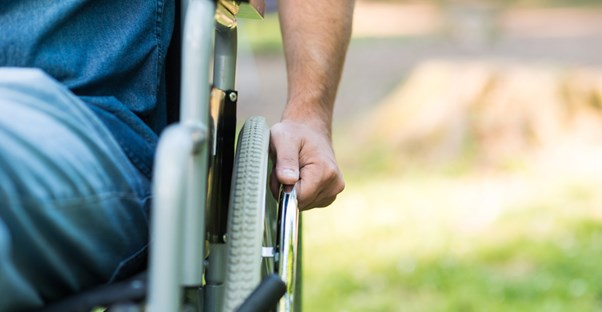If you have multiple sclerosis (MS), one of the keys to managing symptoms is getting regular exercise. And although fatigue and mobility problems may make that more difficult, it can be done. In fact, moving those muscles may be easier than you think.
Multiple sclerosis is a chronic disease that occurs when the immune system attacks myelin, a fatty substance that insulates nerves. As a result, your brain can’t send the proper signals through your body, leading to problems with muscle control and other basic functions.
Symptoms vary widely and range from weakness and fatigue to trouble walking, difficulty sleeping, poor bowel control and depression.
MS treatments include medication, physical rehabilitation and exercise, the National Multiple Sclerosis Society (NMSS) says.
“When you exercise, you get better blood flow and circulation to the brain,” says neurologist Rhonda R. Voskuhl, MD, the Jack H. Skirball Chair in MS Research and director of the Multiple Sclerosis Program at UCLA.
“There’s evidence that exercise can increase stamina, strengthen muscles [and] improve symptoms,” she says.
Doctors once thought exercise helped only by delaying the progression of the disease.
Today, however, they believe that effective exercise programs play a part in repairing the body and restoring physical function, says Timothy Vollmer, MD, medical director of the Rocky Mountain Multiple Sclerosis Center and vice chair for clinical neurology research at the University of Colorado School of Medicine in Aurora.
"Patients can go from walking with a cane to walking without a cane, [even] to running,” Dr. Vollmer says. “With consistent exercise over time, it’s not uncommon for patients with a moderate level of the disease to say they don’t feel like they have MS at all.”
Exercise can also help relieve other common MS symptoms, such as fatigue and depression, according to a 2015 research analysis by the University of Illinois Urbana-Champaign.
But what are the best ways to exercise for MS, especially if the disease itself causes physical problems? Read on for expert tips on how to stay active...
1. Talk to your doctor
Talk to your neurologist before starting an exercise program.
Most doctors will send their MS patients to a physical therapist, who can then customize exercises for them, Dr. Vollmer says. But a qualified personal trainer can also be helpful.
“A trainer will try to push you to make gains,” Dr. Vollmer says. “A physical therapist will work on recovering function and give milder exercises than a trainer.”
2. Exercise for your level of MS severity
Having severe disabilities and using a wheelchair don’t mean you can’t be active. In fact, exercise is an important part of stabilizing your condition and improving function, Dr. Voskuhl says.
Your doctor can help you determine what kinds of exercise are safe and effective for you, she says.
“Whatever [physical activity] you can do, you should continue to do,” she says. “When you stop, muscles atrophy, and you get weaker.”
Exercises designed to stretch arms and legs can be especially beneficial, says Matt Sutliff, a physical therapist and MS specialist at the Cleveland Clinic’s Mellen Center for Multiple Sclerosis in Ohio.
“I have one patient in a wheelchair who plays [the videogame] Wii Tennis with his kids every day,” Sutliff says. “The game stretches his arms, helps improve his heart health, and increases his trunk and arm strength.”
3. Exercise daily for best results
Frequent activity can make a big difference.
That’s because exercise helps nerve cells put out new branches, called neurites, which creates temporary new pathways through which the brain can communicate with the muscles, Dr. Vollmer explains.
Exercising again helps “activate” those pathways and create lasting links, he says.
“If you don’t activate them within 24 hours, you’ve missed the opportunity for the connection,” Dr. Vollmer says.
You don’t need to do a long, intense workout to make that happen. Just exercise as long as you can without becoming overly fatigued, Dr. Vollmer advises.
“Even as little as five to 15 minutes of light exercise can help capture those pathways,” he says. “Just get the body to move and raise the heart rate.”
4. Find the right workout for you
If you like your exercise plan, you’re more likely to keep doing it, Sutliff says.
“One of the first things I ask [patients] is, ‘What do you enjoy?’” Sutliff says. “[For example], some people may dislike going to the gym, so I give them exercises they can do at home.”
Exercises should also be tailored to your individual condition. For example, if you have poor balance, then you shouldn’t do activities that carry a risk of falls, Sutliff says.
Your doctor, a physical therapist or qualified personal trainer can help you determine which exercises are best for your preferences and symptoms, Dr. Vollmer says.
5. Make workouts social
MS patients have a higher likelihood of depression than people with other chronic conditions, such as rheumatoid arthritis.
“These [problems] are caused by changes in the brain,” explains says clinical psychologist Rosalind Kalb, PhD, vice president of the National MS Society’s professional resource center and co-author of Multiple Sclerosis for Dummies (For Dummies Books).
At the same time, fatigue can lead to social isolation and loneliness, which can make the depression worse, Dr. Vollmer says.
Keep physically active and interact with others, he advises. For example, take an exercise class with friends.
“Evidence shows that you’re more likely to continue to exercise if you join a group,” Dr. Vollmer says.
6. Add exercises for balance and flexibility
Gentle workouts, such as yoga and tai chi, can improve flexibility, balance and other symptoms, Dr. Vollmer says. They’re especially helpful for MS patients who have trouble moving easily.
MS patients who practiced yoga for eight weeks improved their balance, coordination, and ability to walk and stand up, a small study 2014 Rutgers University study found.
And those who participated in two weekly tai chi sessions for six months had better balance and coordination and reduced levels of fatigue and depression, according to a 2014 German study published in BMC Neurology.
“Yoga helps to build core [midsection] strength,” Dr. Vollmer explains. “Those with weakness in the lower extremities [such as the legs] tend to focus on those areas, but more strength in the core can help compensate for that weakness.”
When practicing yoga, avoid hyperextending the neck, which could exacerbate MS symptoms, Dr. Vollmer advises.
If you have physical limitations, look for “adaptive” yoga and tai chi classes, in which the practices can be made accessible to your body’s specific needs, the NMMS suggests.
7. Do strength training as well as cardio
You might benefit from weight training along with exercises to improve balance and cardiovascular fitness, but they should be chosen with your abilities and limitations in mind, Sutliff says.
Before you start lifting weights, get guidance on correct form and using the right amount of weight from a trainer or your doctor.
Also, start out with machines rather than free weights, especially if you’re unaccustomed to weightlifting.
“The free weights can collapse on you if you don’t realize that you’re getting to the end of your endurance,” Dr. Vollmer warns.
If you have mild weakness in the lower extremities, body-weight exercises such as squats and planks are good for core strengthening, Dr. Vollmer adds.
Patients with moderate-level impairment might need to stick with machines that combine aerobic training with resistance, such as a recumbent (seated) steppers and stationary bicycles. These can help combat stiffness or spasms in the leg muscles, Dr. Vollmer says.
Start slowly and build your strength gradually, Sutliff advises.
Two hours after exercising, you should feel the same or better than when you started. If you’re feeling worse or tired, you did too much, he warns.
8. Stay cool
MS symptoms can worsen when body temperature rises, Dr. Vollmer says. That’s because heat causes a reaction that interferes with electrical signals through the nerve fibers.
So it’s important not to get overheated due to exercise or hot, humid outdoor conditions.
Sports like rowing and swimming are good activities for people with MS, Sutliff says. But make sure the water is no warmer than 80 to 85 degrees Fahrenheit.
If you tend to get overheated while exercising, “use cooling vests, collars or towels to keep the core body temperature down,” he says. “Taking short breaks while drinking ice water also helps to stay cool and hydrated.”
Walking outdoors in hot weather? Use an umbrella to keep the sun off and spend as much time as possible in the shade, Sutliff advises.
If you overheat, try not to worry too much, Dr. Voskuhl adds. A worsening of symptoms is temporary, and you’ll return to normal when you stop exercising and cool down.
“People may think it’s bad to exercise, but they’re just feeling bad because they’re overheated,” Dr. Voskuhl says. “That is not the same as having a relapse – nerves are not damaged by exercising.”
Remember that staying healthy requires a comprehensive approach, Dr. Vollmer adds. That includes exercise, a nutritious diet and relaxation techniques such as mindfulness meditation.
“The combination really helps to improve quality of life in a dramatic way,” Dr. Vollmer says.
“[Mindfulness] helps you stop dwelling on future outcomes and focus on the here and now,” he says. “Exercising the entire body helps to maximize lifelong brain health.”
To learn more about living with multiple sclerosis, visit Lifescript’s Multiple Sclerosis Health Center.



